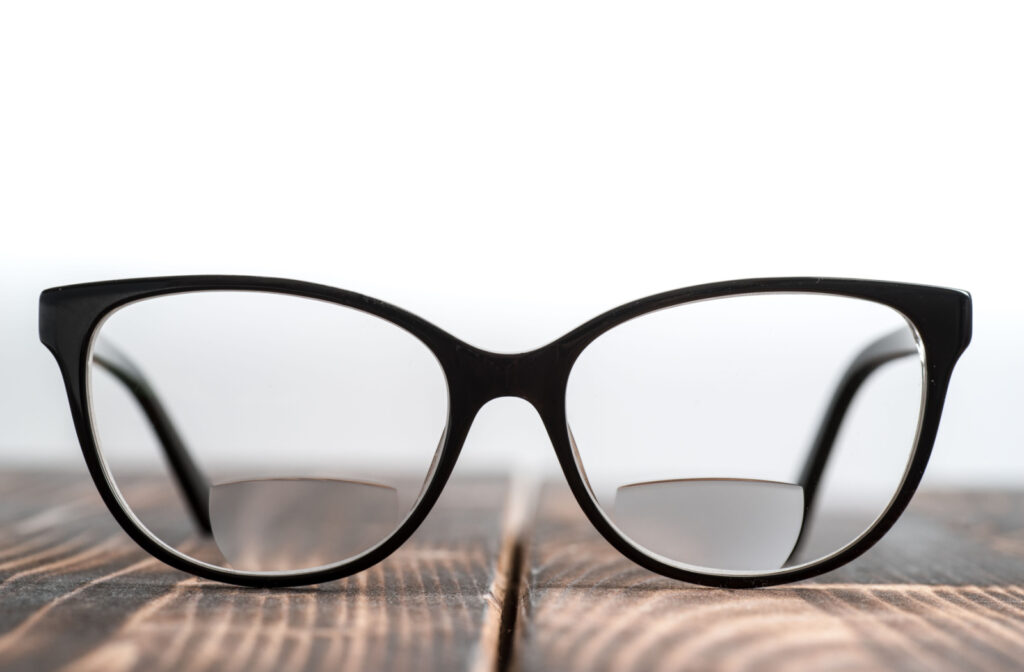Whether you’ve been wearing glasses, contacts or have a perfectly normal vision, there’d come a time, mostly while on the wrong side of 40, when you’ll start experiencing reading difficulty. This is a clear sign that you’re on the brink of developing presbyopia—a farsightedness problem brought about when the eye lens loses elasticity. While anyone can develop presbyopia, the problem tends to be more pronounced among those who wear contact lenses, and the only prescribed solution for this is the line-free progressive lenses, or the conventional bifocals and trifocals.
A majority of eye specialists and opticians recommend bifocals and trifocals over other lenses, as they tend to offer a much wider lens area for reading and doing other close up tasks. It should also be mentioned that there are many other special purpose bifocal and trifocal designs, specifically designed for tasks that require picture-perfect intermediate and near vision.
Bifocal Lenses

As you could have guessed, bifocal lenses come with two lens power—one for correcting farsightedness and the other one for correcting near-sightedness. The lower half is designed with a near segment for close-up tasks, whereas the rest of the lens is for correcting farsightedness, although it can still come with no correction at all if your vision is good enough.
First developed by Benjamin Franklin, bifocals remained in style for almost a century, until in the 1900s when they were made thinner and more attractive. The most popular bifocal today spots the D-shaped near segment rotated at a right angle so that the flat part of the ‘D’ can face up. It’s for this reason that the D-segment bifocals are referred to as either the ‘Straight-Top’ (ST) or ‘Flat-Top’ (FT) bifocals. Flat-Top bifocals can further be described by their near segment width (measured in millimetres). Speaking of which, the FT-28 (a bifocal with a near segment 28 mm wide) is the most popular bifocal.
Another fused bifocal picking up really fast is the round segment bifocal. One advantage with this type of bifocal is that it’s designed with lines separating the near and distance zones of the lens, thus making them less noticeable unlike D-seg bifocals.
Although bifocals are great for reading and driving, they are sometimes limited when it comes to seeing objects in the intermediate zone. It’s for this reason that trifocals were created.
Trifocal Lenses
Trifocals boast an additional ribbon-shaped segment, placed above the near segment for sighting in-between distances in your line of vision, mostly 18 to 24 inches away. The intermediate segment is designed to provide approximately 50 percent of the added near seg’s magnifying power, making it perfect for viewing your computer, speedometer or any other item on your car dashboard while driving.
Trifocals are best recommended for presbyopes over 50 years old, with awfully diminished depth of focus and who’d like to have a clear vision of objects placed at arm’s length.
Again, as with bifocals, the most -popular trifocals are the FT-28 designs, which come with 28 mm wide near and intermediate segments.
Fitting Guidelines
Bifocals are typically designed with the near segment resting almost at the same level as the wearer’s lower eyelid, whereas the near segs in trifocals are fitted a little higher, with the top of intermediate segment aligned with the wearer’s lower margin of the pupil. This placement ensures your eyes can typically look through the viewing zones of your lenses without requiring you to make posture adjustments or tilt your head. But you can still ask your optician to position the segs lower or higher depending on your needs and preference.
Choosing the right bifocals or trifocals for you
Choose a bifocal with the reading prescription if you’re looking for nothing more than a reading glass. The same can be said to people with astigmatism.
To help you choose the right bifocal or trifocal lens, we will begin by examining the size of your pupil and its near vision power. At times the we may suggest different designs while helping you to decide on one best suited for you.
How to Know When You Need Bifocals and Trifocals
To know when it’s right for you to get a bifocal or trifocal you first need to understand the problem at hand. First you have to understand that presbyopia is a common vision problem that will eventually catch up with you once you register age 40.
In most people the problem surfaces when they’re in their mid-40s, even though it can still come earlier than that. Here are the signs to look for and know when exactly you need a multi-focal:
- Eye fatigue when reading. This is usually accompanied by bouts of mild headaches when reading or looking at items that are very close.
- Blurred vision when looking at items placed at normal distance.
- Holding magazines, newspapers, and books at arm’s length to read.
If you’re beginning to notice these symptoms or have any other reason to believe that you may need bifocal or trifocal lenses, call the Eye Care Center of Colorado Springs at (719) 576-5844. We’ll give you a comprehensive examination and help you to find the prescription glasses that are perfect for your vision and your style!


